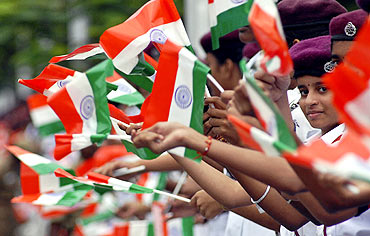

In the endless list of policy prescriptions made by the pundits after the declaration of the general election results there has been precious little commentary on possible judicial reforms despite a near national consensus that our judicial system is broken. This is a rather surprising state of affairs given the lost decade of judicial reforms under the UPA government. On the rare occasion that the national conversation veers towards the topic of clearing the pendency backlog, the ideas under discussion are rather uninspiring. Suggestions for evening courts or fewer court holidays fail to understand the fundamental problems with the Indian judicial system.
INDIA has been growing steadily richer in recent years, but it still has more malnourished people, especially children, than any other country. A big, nationwide study from 2005 and 2006, the National Family Health Survey (NFHS), found that 42.5% of children under five years old were underweight. The region with the next highest proportion of underweight children is Africa, with an average of 21%. Another measure of malnutrition is stunting, when children are unusually short for their age. Again, India’s problems were shown to be unusually bad.
Now comes some good news. In 2013 and 2014 the UN agency for children, Unicef, and India’s government conducted a new study called the Rapid Survey on Children (RSOC). The purpose was to gather up-to-date figures to use in the interim before the next big NFHS survey, which is under way. The RSOC report has unfortunately not been published, but The Economist obtained a copy.
It points to some striking national trends. For example the proportion of underweight children has fallen from 42.5% a decade ago, to just under 30% now. There have been similar improvements on stunting, wasting and other measures of malnutrition. The national immunisation rate has risen and the rate of open defecation is down from 55% of households to 45%.
Really interesting, however, is the breakdown of results by state, presented here. By and large social and health indicators across India follow predictable patterns. In states with higher incomes, those nearer the coast and farther south, most health indicators are better. Typical high achievers are Kerala and Tamil Nadu. In landlocked states, poorer ones and in the north, social and health results are usually worse. Notorious backward states include Bihar and Uttar Pradesh. North-eastern states are often outliers, both poor and landlocked but often with high rates of literacy and better health.
Results from the RSOC mostly bear out these trends. Everywhere has seen a reduction in the share of underweight children and in stunting. But it is striking that on occasion higher incomes do not correlate with the biggest health gains. Maharashtra and Gujarat are both states with relatively prosperous people, but Maharashtra’s nutrition levels are better than Gujarat’s. This is also true for rates of immunisation and of open defecation. It appears that Maharashtra’s government has put more emphasis on tackling nutrition problems, for example among its adivasi, or tribal, population.
Two crucial factors are worth looking at. Lower rates of open defecation correlate well with reduced malnutrition. When children live and play in clean environments they are less likely to be infected with parasites that make it hard to absorb nutrients. And states that focus on helping girls and young mothers probably do better at breaking long-term cycles of malnutrition. Where teenage girls have a low body-mass index there seems a greater likelihood mothers will give birth to undernourished children. Proper nutrition for girls and women should be a priority.


Pendency is only one issue facing the Indian judiciary. The more substantial issues concern the quality of justice and accountability. Both these issues are inextricably linked to the lack of transparency in almost all aspects of the judiciary’s functioning and there is precious little that is being done to remedy the situation.
As the RTI Act has demonstrated, transparency can dramatically alter the status quo in powerful institutions because as Justice Brandies once commented “sunlight is said to be the best of disinfectants” and the Indian judiciary needs a lot of sunlight. Unfortunately, as will be explained below, the Indian judiciary has almost excluded itself from the ambit of the RTI Act.
Accountability through statistics
Let’s start with the issue of statistics on case pendency and judicial backlog. There is no single database in the country which collects statistics regarding various aspects of pending cases in each and every courtroom of India. In 2004 eminent lawyer and Senior Advocate Mr. Fali S. Nariman who was then a MP in the Rajya Sabha introduced in Parliament the Judicial Statistics Bill, 2004. This proposed legislation was aimed at creating authorities at the national and state level to collect, in a scientific manner, statistics from each and every courtroom regarding the hours taken by the Court to hear the dispute, the time between the filing of the case and hearing by the court, the adjournments granted, time taken for delivery of judgment after it has been reserved, along with the names of the lawyers and judges responsible for the case. Imagine the possibilities if all this data was made available on a computerized database. Not only would it provide information on the efficacy of the judges but also help litigants separate the litigating lawyers from the adjournment lawyers. (Frontline carried an interesting story on the bill over here.)
Nariman’s intention of introducing such a bill was to help in better data collection so as to facilitate a better study of the judiciary but was against using it as a tool of accountability. In his interview to Frontline, he said “I don’t like confrontation with the judiciary. The objective is to try and discern whether anything can be done better by inspiring judges and lawyers. The Bill cannot be a new source of litigation. A citizen, if properly motivated, can use the statistics, provide for himself a mechanism and an opportunity to get greater inputs than what is now available, to do something without the fear of contempt.”
Notwithstanding Nariman’s stand, the true value of this data collected through the Judicial Statistics Bill, 2004 was the tremendous impact that it would have on judicial accountability because once statistics on the functioning of courts are placed in the public domain it is only a matter of time before policy wonks can track trends and publicly separate the inefficient courtrooms from the efficient court rooms. Unfortunately for India, the UPA lacked the vision to enact this bill.
For far too long the judiciary has taken refuge under the cloak of judicial independence to avoid any accountability
The judiciary’s battle against the RTI
The battle for greater transparency in the internal workings of the judiciary should have strengthened after the enactment of the Right to Information Act. Unfortunately, judicial attitudes to the RTI Act, especially that of the Supreme Court’s Registry, have been rather hostile. Three cases highlight the judicial ‘hostility’ to the RTI Act.
In the first case, when a RTI activist filed an application with the Supreme Court, in 2007, asking for disclosure of the assets of all Supreme Court judges the Registry of the Supreme Court fought the RTI applicant all the way to the Delhi High Court which ordered the Supreme Court Registry to disclose the information in 2009. (The judgment can be read here) Even then the Supreme Court Registry appealed to the Supreme Court itself but after a revolt in the ranks the list of assets were made public. The appeal to the Supreme Court is yet to be decided.
In the second case, a RTI activist Commodore Batra, had filed a RTI application with the Supreme Court asking for the number of cases reserved by its judges for judgment between 2007 and 2009. The Supreme Court Registry refused to provide such information on the grounds that it did not maintain such records. The Central Information Commission (CIC) over-ruled the Supreme Court Registry on August 3, 2011 and ordered the Registry to provide the information to the applicant. Instead of conceding to the CIC, the Supreme Court filed an appeal before the Delhi High Court in 2011 and the matter has been pending since then.
The third case involves the applicability of the RTI Act to legal pleadings and other public documents held by registries of various courts. Even before the RTI Act, the internal rules of most courts across the country allowed for litigants to access pleadings held by the registry. The difference between the internal rules of these Courts and the RTI Act is that the latter provides for a delightfully simply mechanism to access the information. On the other hand, accessing information under the internal rules of the court is complicated and out of bounds for most common people who will have to conduct the process through a lawyer or a court clerk. Most courts across the country, including the Registry of the Supreme Court have flat out rejected the applicability of the RTI Act to access pleadings that are otherwise available under the internal rules of the Court.
In contradictory decisions, two different commissioners of the CIC came to diametrically opposite conclusions. The CIC judgment ordering the Supreme Court Registry to make available even pleadings under the RTI Act has been appealed to the Delhi High Court by the Registrar of the Supreme Court in 2011 and the appeal continues to languish before the High Court.
Forcing transparency on the judiciary
Like all powerful institutions the judiciary isn’t going to volunteer more information about itself because it is well aware that increased transparency will make it more vulnerable to criticism. At times, arguments have been made that increased transparency will impinge on judicial independence. However such arguments need to be dismissed with contempt.
As Nariman stated in his interview with Frontline “Judicial independence means deciding cases without being influenced by anybody. But disseminating information about how many cases get decided in the courts will not compromise judicial independence at all. This is a wrong impression that the judiciary, among all organs of the government, must remain totally secretive, and nobody must know anything that is happening in the judiciary.”
For far too long the judiciary has taken refuge under the cloak of judicial independence to avoid any accountability.
Parliament must enact the Judicial Statistics Bill, 2004 along with amendments to the RTI Act to force the judiciary to be more transparent.
A long-awaited report on electoral reforms issued by India’s law commission has failed to introduce a ceiling on poll spending by parties, perhaps the most serious lacuna in the country’s political system, because it gives a huge advantage to those supported by the wealthy.

The main loophole with disclosure was the fact that while parties had to reveal to the election commission the names of donors who gave amounts greater than Rs20,000, they did not have to do so for smaller sums. In order to avoid disclosure, parties therefore often broke up larger donations from one source into parcels of less than Rs20,000.

Stricter penalties
Parties will attract heavier penalties for not filing information or not doing so on time. If the election commission finds a party to have wilfully filed wrong information, it can now levy a fine of up to Rs50 lakh.

Given that none of the major parties filed expenditure statements on time after the 2014 general elections, these higher penalties could help. The deadline to file expenditures was August 26, 2014, but the two major parties—the Congress and the BJP—filed their expenses only in December and January, respectively.


















